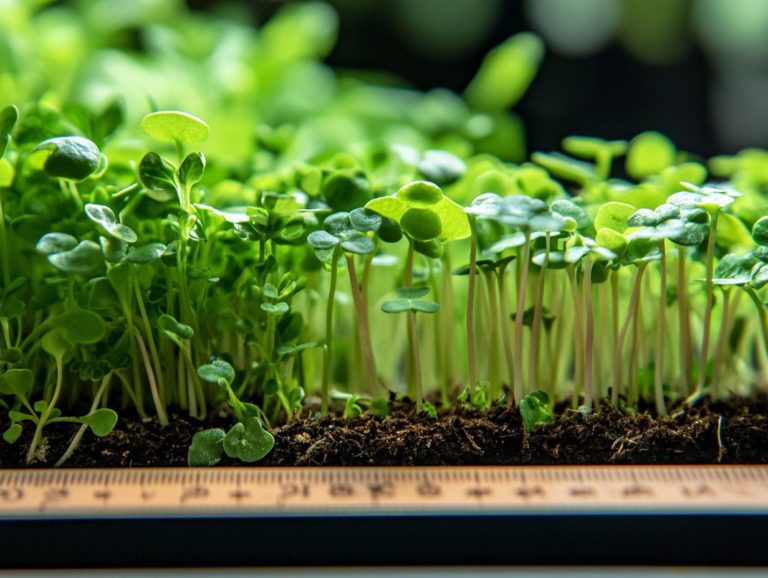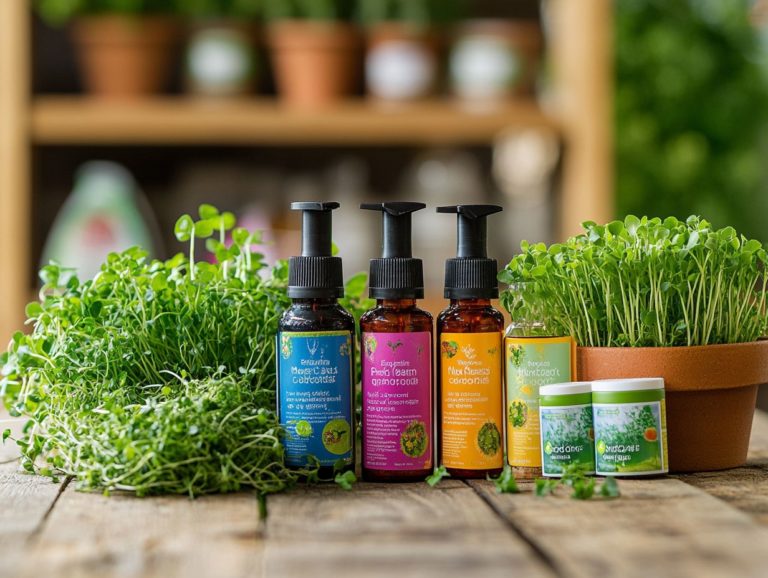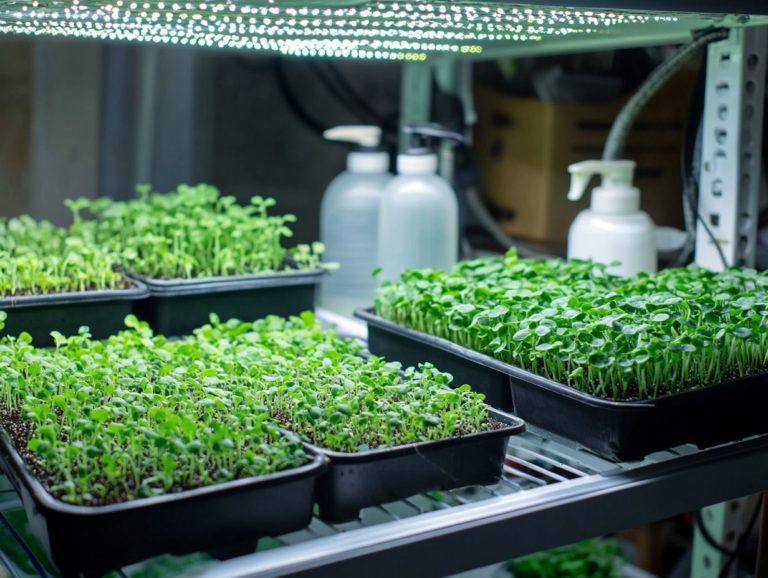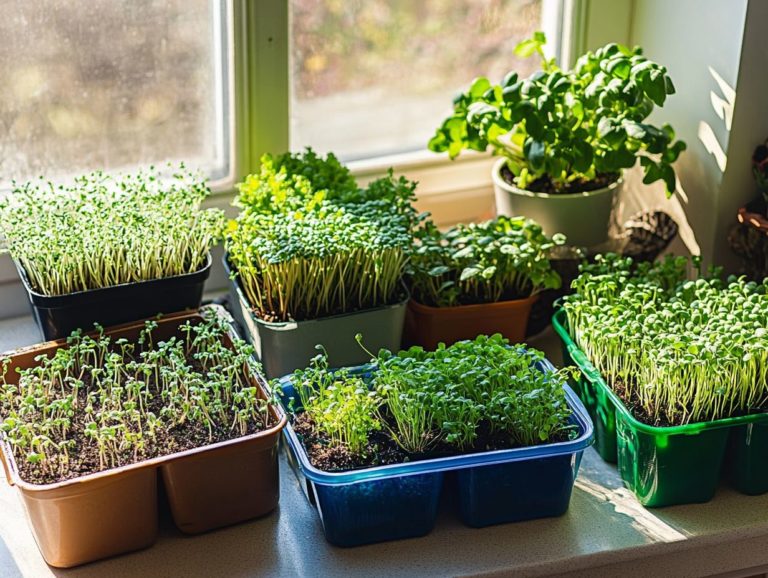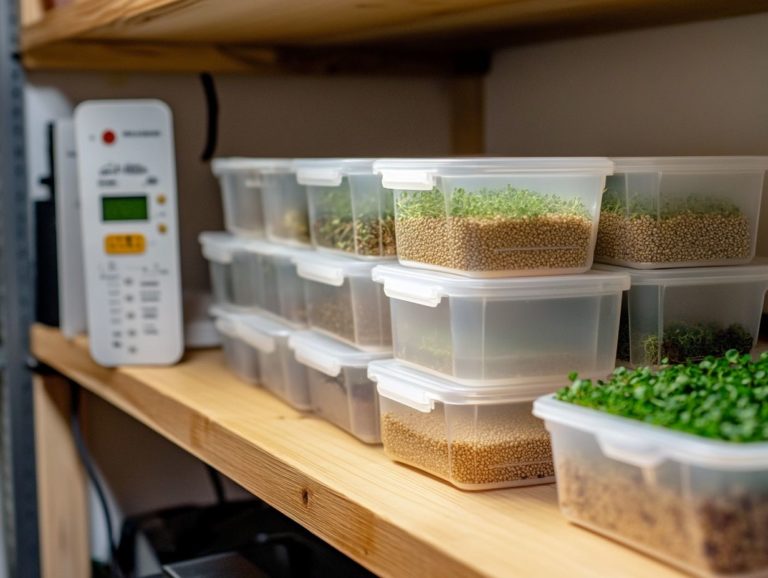How to Select the Best Microgreen Trays
Microgreens are a delightful addition to your kitchen garden, providing a burst of flavor and nutrients within a compact space.
To cultivate these tiny greens successfully, selecting the right microgreen trays is essential. This article delves into vital factors you should consider such as size, material, drainage, and cost while also exploring the various types of trays available on the market.
You ll also find handy tips for using and maintaining your trays to ensure a bountiful harvest. Discover how to select the best microgreen trays for your gardening journey!
Contents
- Key Takeaways:
- What are Microgreen Trays?
- Factors to Consider when Choosing Microgreen Trays
- Types of Microgreen Trays
- Tips for Using and Maintaining Microgreen Trays
- Frequently Asked Questions
- What are the important factors to consider when selecting microgreen trays?
- Wondering what materials are best for microgreen trays?
- What size tray is best for growing microgreens?
- Do I need a tray with drainage holes for growing microgreens?
- Can I reuse microgreen trays?
- What is the best type of tray for growing microgreens?
Key Takeaways:
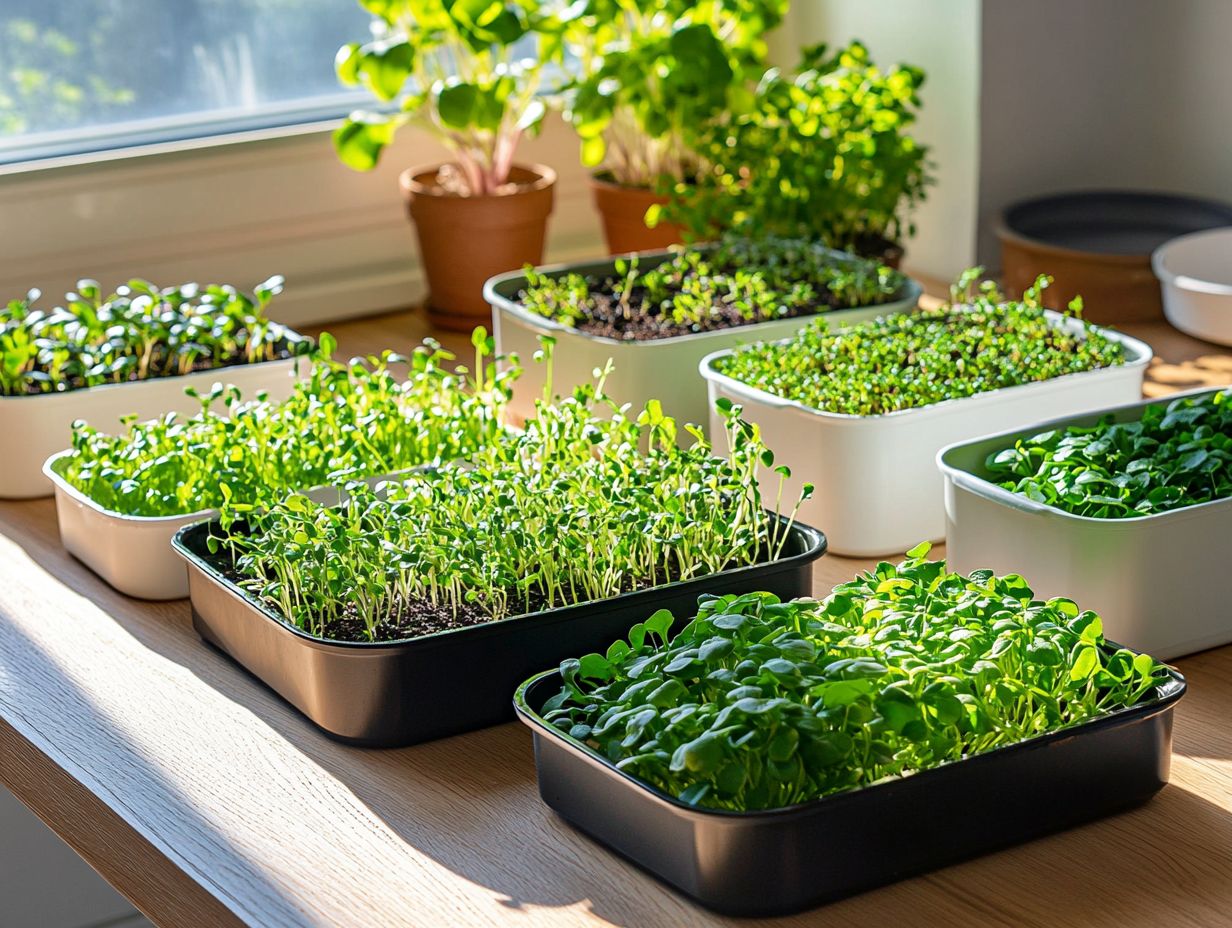
- Think about size, material, drainage, and ventilation as you choose your microgreen trays. These factors can lead to optimal growth and efficiency!
- Choose from standard, stackable, or biodegradable trays based on your needs and preferences for growing microgreens.
- Proper watering, regular cleaning, and selecting the right trays are essential for successful microgreen growth and maintenance.
What are Microgreen Trays?
Microgreen trays are expertly crafted containers tailored for cultivating microgreens those vibrant, nutrient-packed young plants that are harvested right after their first true leaves appear. These trays, including top choices like Bootstrap Farmer trays, hold different types of soil such as coconut coir and peat moss.
Essential for successful microgreen farming, these trays enable you to experiment with different planting techniques. Tune into a microgreens podcast for exciting trends and tips that will elevate your gardening game!
Factors to Consider when Choosing Microgreen Trays
When you re choosing microgreen trays, several key factors can greatly influence your success in cultivating these vibrant greens at home. It s essential to consider aspects like the material, size, drainage capabilities, and overall durability of the trays.
Experts often highlight the significance of these criteria, as they directly affect growth rates and yield. By paying attention to these details, you can ensure that you select the best microgreen trays tailored to your specific growing requirements. Additionally, learning how to select the right microgreen seeds can further enhance your success.
Size and Material
The size and material of your microgreen growing trays are crucial factors that influence both plant growth and maintenance ease. Opting for trays made from high-quality plastic or biodegradable materials, like coconut coir, ensures proper drainage and supports various soil media for microgreens, enhancing their growth potential.
The dimensions of your trays significantly affect light exposure; larger trays provide more surface area, promoting better photosynthesis and leading to healthier growth. Choose materials that allow for good airflow to encourage robust root systems, vital for overall plant health.
Drainage and Ventilation
Effective drainage and ventilation are essential when using microgreens growing trays, directly impacting the health of your plants. Trays designed for bottom watering and equipped with appropriate designs ensure that excess water drains properly, preventing soil waterlogging making them perfect for your home gardening efforts.
When you choose your trays, opt for those crafted from breathable materials that promote good air circulation. This is crucial for preventing mold and encouraging robust root development.
Trays featuring perforations or mesh bottoms are particularly advantageous, as they facilitate proper drainage and limit water retention, significantly reducing the risk of root rot, a condition where roots decay due to excess moisture.
To elevate your yield further, think about adding a simple humidity dome. This will help maintain optimal moisture levels while ensuring adequate airflow. By understanding these features, you can substantially improve the overall growth conditions, transforming your journey of cultivating microgreens into a more rewarding and successful experience.
Cost and Reusability
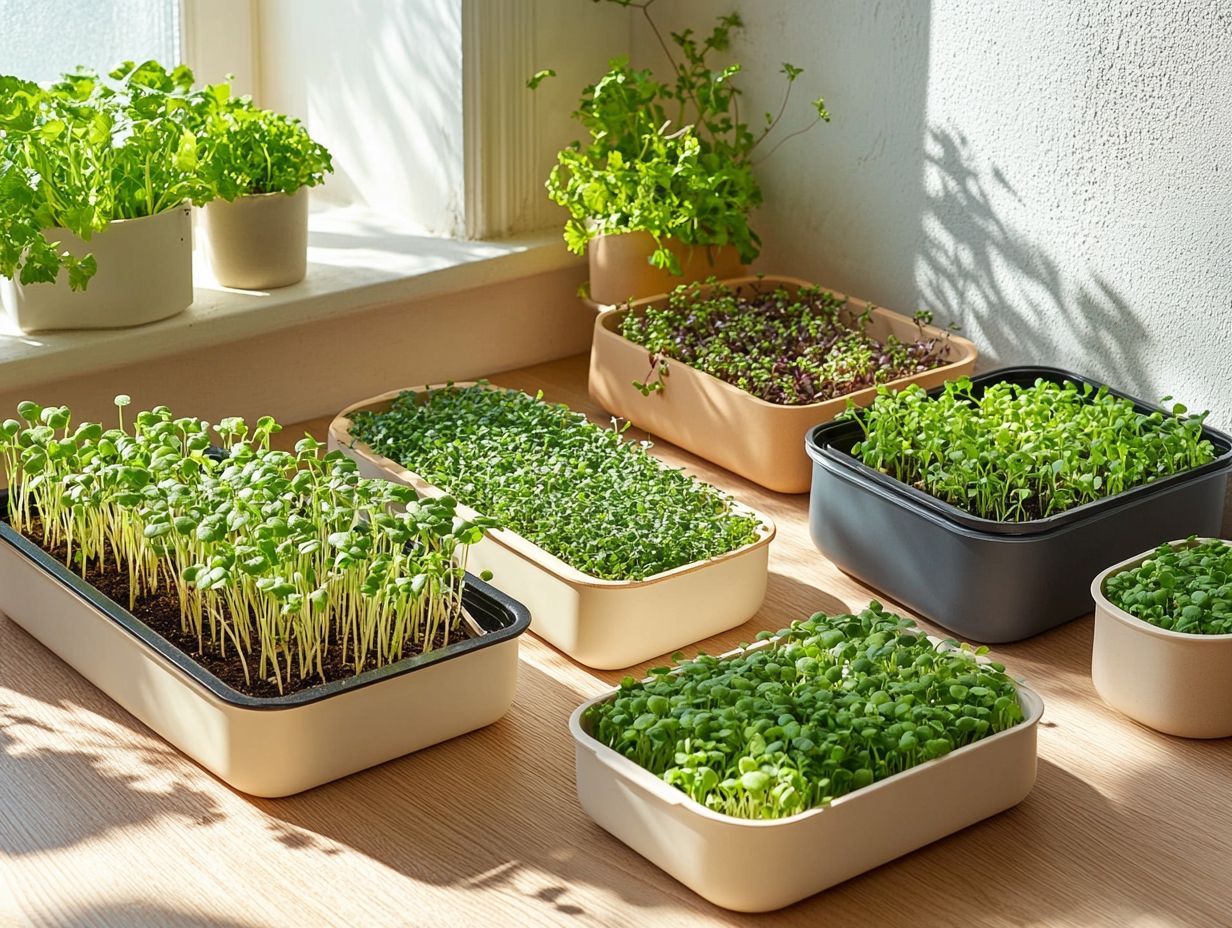
Cost and reusability are pivotal factors in your choice of microgreens growing trays. This is especially important if you’re keen on maximizing your gardening investment.
While high-quality microgreen trays may seem pricier upfront, their durability and ability to be reused across multiple growing cycles often make them the ideal choice for both novice and seasoned gardeners. By investing in sturdy trays, especially when using sprouting trays for microgreens, you’ll find yourself making fewer replacements over time. This leads to big savings over time.
You can take comfort in knowing that a durable tray won’t crack or degrade after just a handful of uses. This allows you to cultivate a variety of microgreens through different seasons. Such adaptability makes your gardening experience even better! It also supports eco-friendly practices by reducing waste. By opting for well-constructed trays, you can relish the dual benefits of reliable performance from the get-go and long-term value derived from sustained productivity and versatility in your gardening endeavors, especially when you use the best substrates for microgreen growing.
Types of Microgreen Trays
Grasping the various types of microgreen trays at your disposal is crucial for elevating your growing experience and securing fruitful yields. The primary options include:
- Standard trays
- Stackable trays that help you make the most of your space
- Biodegradable trays designed for the eco-conscious gardener
Each type boasts distinct features, tailored to meet a range of growing requirements and personal preferences.
Standard Trays
Standard trays are the go-to choice for microgreen enthusiasts. They are expertly crafted to provide ample space for a diverse array of microgreens in your home garden.
With drainage holes included, these trays seamlessly accommodate various soil media, making them versatile enough to suit different growing techniques. Not only do these trays elevate your growing experience, but they also offer a level of flexibility that appeals to both beginners and seasoned growers alike.
Their cost-effectiveness is hard to overlook, allowing you to explore a range of microgreen varieties without breaking the bank. However, while standard trays shine in their practical design, they do have their limitations regarding capacity and space efficiency, particularly when you’re aiming to grow larger batches. To maximize your efforts, it’s important to learn the best methods for storing microgreens.
The success of your microgreen cultivation often hinges on choosing the right container; after all, the dimensions and drainage capabilities can significantly impact your growth and yield.
Stackable Trays
Stackable trays offer a brilliant solution for cultivating microgreens. They allow you to save precious space while maximizing your yield. You ll often hear them praised in microgreens podcasts for their efficiency, enabling you to grow multiple layers without compromising on light and air access.
These trays have drainage systems that help prevent overwatering, ensuring your plants thrive in optimal conditions. By making use of vertical space, even if you’re living in a cozy apartment, you can enjoy a continuous supply of fresh greens.
Gardening enthusiasts frequently emphasize how these trays simplify the gardening process, making it accessible for beginners while still providing a rewarding experience for seasoned growers. The ease of stacking and unstacking these trays not only streamlines harvesting and maintenance but also transforms gardening into a more enjoyable and efficient endeavor.
In conclusion, choosing the right microgreen trays can enhance your gardening experience, save you money, and contribute to eco-friendly practices. Whether you opt for standard, stackable, or biodegradable trays, each type offers unique benefits tailored to your needs.
Ready to start your microgreens journey? Choose the right trays today and watch your garden flourish!
Biodegradable Trays
Biodegradable trays are a great eco-friendly choice for growing microgreens. They combine functionality with sustainability and are often made from compostable materials.
These trays not only help start seeds but also reduce plastic waste in gardening. This choice is perfect for environmentally conscious gardeners who want to lessen their ecological footprint.
By using biodegradable trays, you support the earth’s health while enjoying vibrant plants. For those interested in growing microgreens, having the right tools is crucial. Check out the must-have equipment for microgreen cultivation. As more people adopt sustainable practices, these trays help connect us to nature and promote soil health and biodiversity.
Tips for Using and Maintaining Microgreen Trays
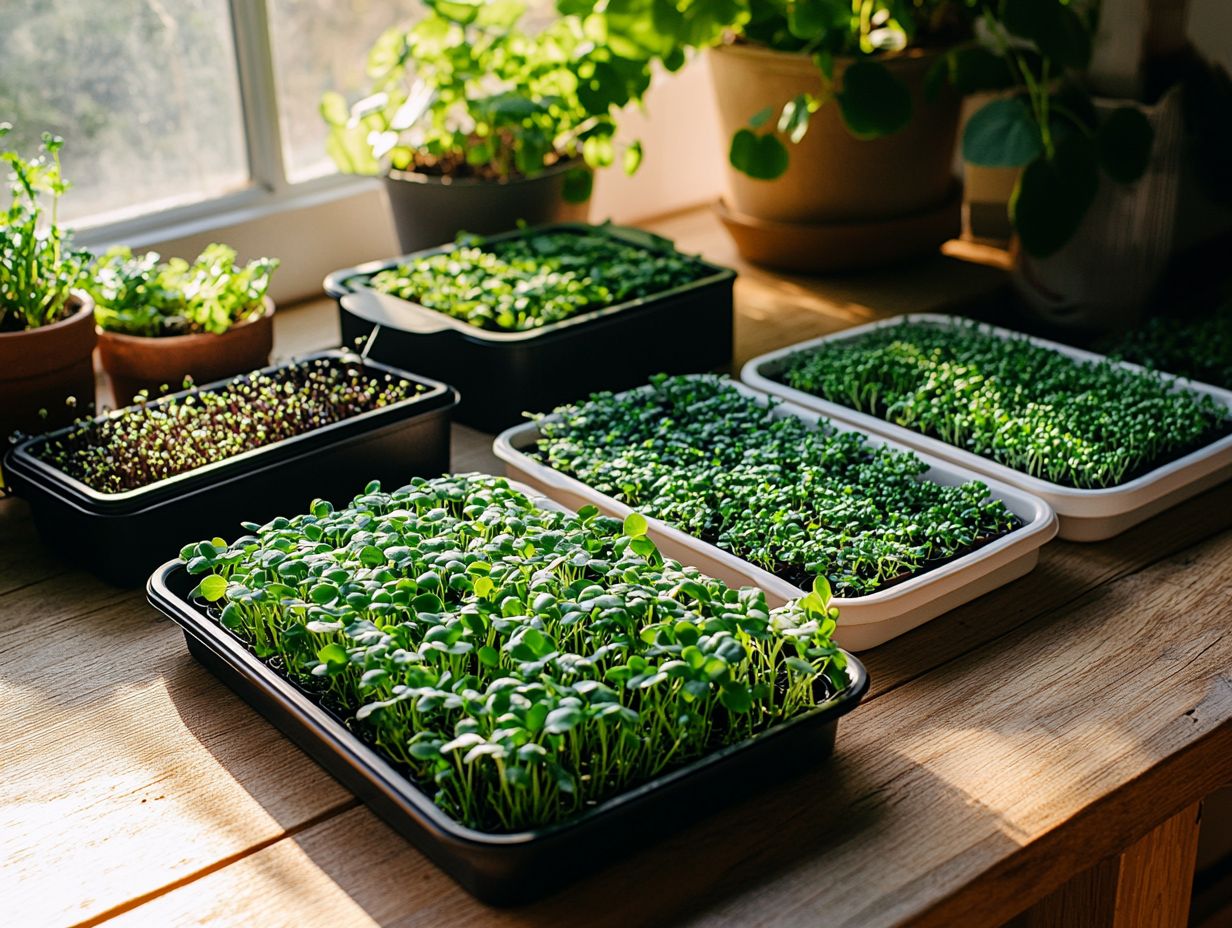
To get the most from your microgreen trays, follow these important tips! Proper watering techniques, like bottom watering, promote healthier roots.
Use effective cleaning methods to keep mold and disease at bay. By doing this, you create an ideal environment for your microgreens.
Proper Watering and Care
Watering and care are key to growing microgreens successfully. Bottom watering is one effective method that keeps soil evenly moist.
This technique involves placing trays in shallow water, allowing moisture to rise from the bottom. It keeps the leaves dry to prevent mold and encourages deeper root growth as plants seek moisture.
Regularly check the weight of your trays to maintain moisture levels. A moisture meter can help you avoid over or under-watering, which is essential for healthy microgreens.
Cleaning and Sterilization
Cleaning your microgreen trays is essential to keep them durable and free from pests. Regular cleaning extends the lifespan of your trays and supports healthier crops.
Use a gentle scrub brush and a mix of warm water and mild soap. Rinse thoroughly to remove soap residue.
To sterilize, soak trays in a bleach solution one part bleach to ten parts water for 10-15 minutes. This method helps eliminate harmful microbes.
Dry your trays in direct sunlight for extra sanitization. These cleaning habits significantly reduce the risk of disease and give your microgreens the best start!
Choosing the Right Microgreen Trays for Your Needs
Choosing the right microgreen trays can be fun! It s an essential step on your path to growing healthy microgreens. Take time to consider several factors to ensure you select high-quality trays that match your specific growing conditions and preferences.
First, evaluate your available space. Different tray sizes cater to various locations, whether you’re using a sunny windowsill or a dedicated indoor garden.
Next, think about the materials you prefer. Plastic trays are lightweight and easy to handle, while biodegradable options allow you to embrace eco-friendly practices. Don t forget about drainage capabilities; effective drainage is vital to prevent root rot and keep your microgreens thriving.
To maximize vertical growing areas, consider stacking trays. This ensures that ample light reaches your plants. These thoughtful choices greatly impact the health of your microgreens and enhance your gardening experience.
Frequently Asked Questions
What are the important factors to consider when selecting microgreen trays?
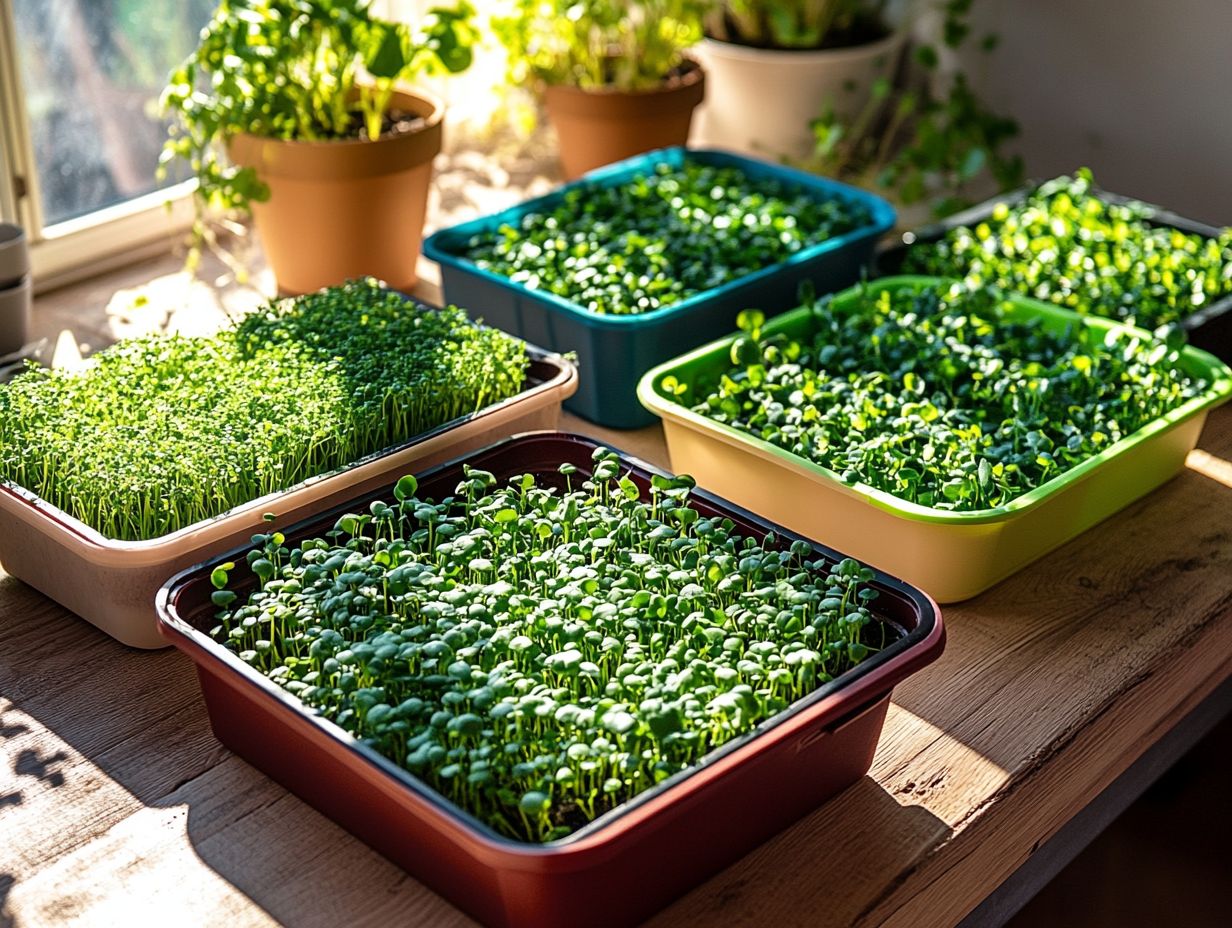
Some important factors to consider when selecting microgreen trays include material, size, drainage, and durability. Choose a tray made of a non-toxic material that is the right size for your needs. Ensure it has adequate drainage and is durable enough to last through multiple uses.
Wondering what materials are best for microgreen trays?
Common materials for microgreen trays include plastic, wood, and biodegradable options. Plastic trays are affordable and lightweight, while wood trays are sturdy and reusable. Biodegradable trays are eco-friendly but may not last as long as other options.
What size tray is best for growing microgreens?
The best size tray for microgreens depends on your available space and how many microgreens you want to grow. Standard sizes typically range from 10×20 inches to 17×17 inches. Smaller trays are ideal for beginners, while larger trays suit those looking to produce bigger quantities.
Do I need a tray with drainage holes for growing microgreens?
Yes! Drainage holes are essential for growing microgreens. They allow excess water to drain out and prevent root rot. Without proper drainage, your microgreens may become waterlogged and die. Look for trays with drainage holes, or create them yourself if needed.
Can I reuse microgreen trays?
Absolutely! Many microgreen trays can be reused multiple times if they are made of durable material and cleaned properly between uses. For plastic trays, choose BPA-free and food-safe options. Wood trays should be cleaned with mild soap and water, while biodegradable trays can be composted after use.
What is the best type of tray for growing microgreens?
The best type of tray for growing microgreens depends on your personal preferences and needs. Plastic trays are affordable and lightweight, while wood trays are more durable and reusable. Biodegradable trays are eco-friendly but may not last as long. Consider what factors are most important to you before making a selection.
Start growing your microgreens today with the perfect trays!

